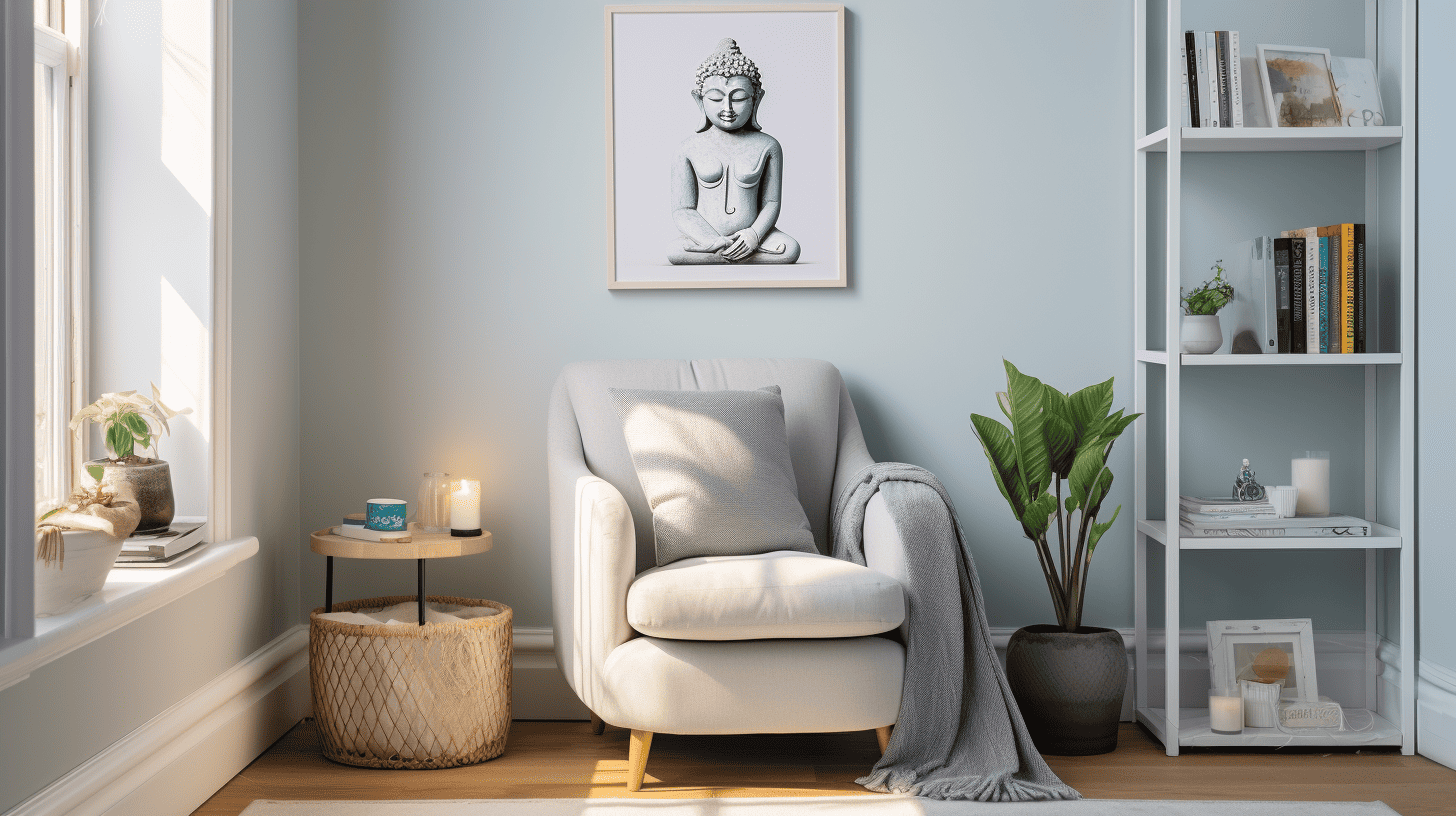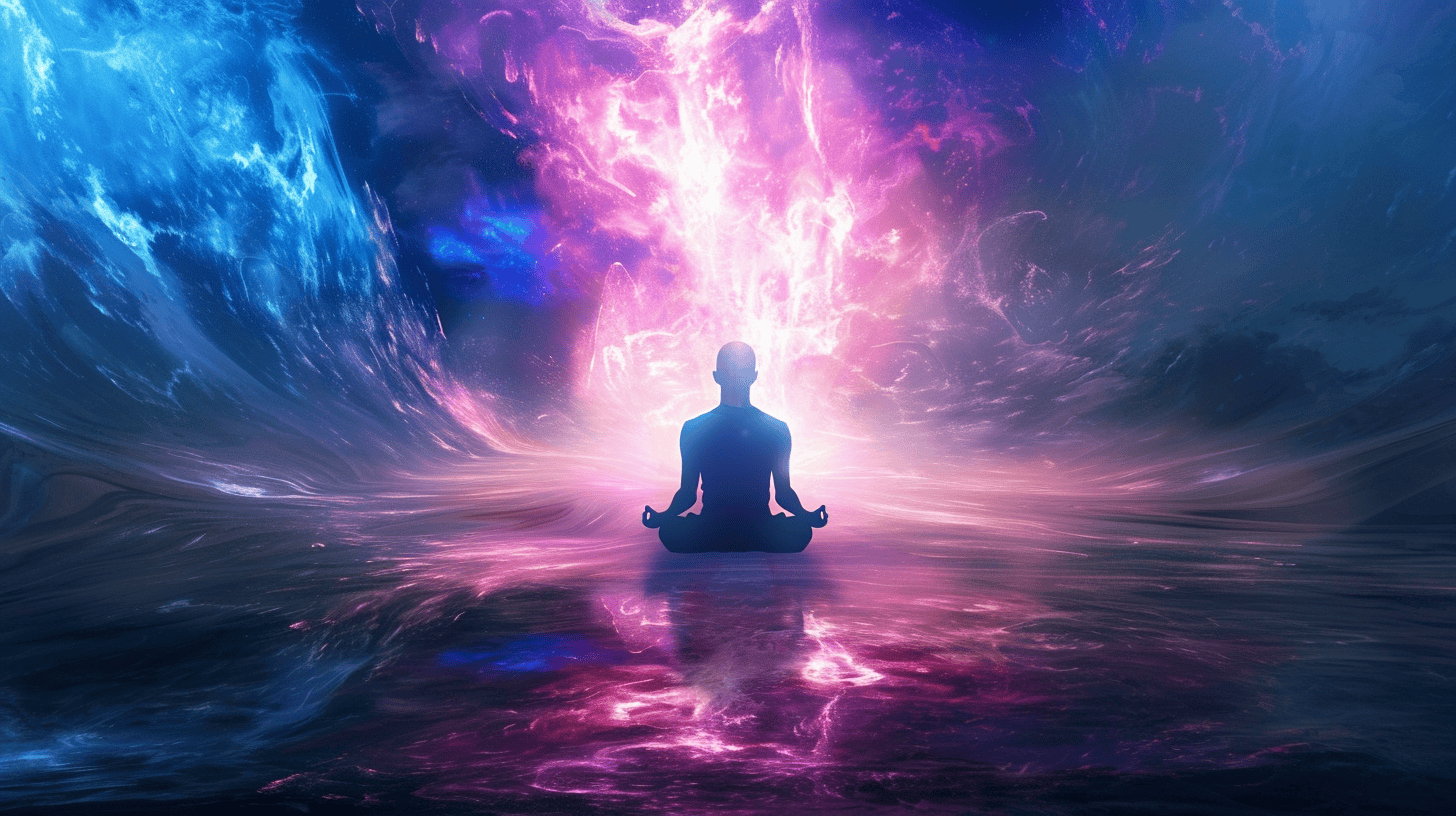Anxiety is a common condition that affects millions of people. While medication can help in some cases, many natural techniques and exercises can help reduce anxiety without the need for drugs. I’ll share 15 research-backed methods for lowering anxiety and improving mental health in this article.
I have included meditation exercises for anxiety PDF links in each section of this article.
Key Takeaways
- Breathing exercises, muscle relaxation, meditation, guided imagery, and mindfulness are fast-acting techniques to reverse anxiety at the moment.
- Movement practices like yoga, tai chi, and walking meditation combine physical activity with mindfulness for anxiety relief.
- CBT, journaling, and art therapy utilize expressive processes to gain awareness of thought patterns driving anxiety.
- Aromatherapy, positive psychology, and time in nature incorporate pleasant sensory experiences to boost relaxation.
- Anxiety reduction skills must be practiced regularly – even when calm – to become automatic habits when needed most.
- Natural anxiety relief methods require patience as you build cumulatively more significant inner reserves of mindfulness and resilience.
1. Breathing Exercises
One of the fastest ways to reduce feelings of anxiety is to practice deep breathing exercises. When you experience anxiety, you might notice your breathing becomes short and shallow, which further increases stress and panic.
Breathing Exercises PDFs:
https://uhs.berkeley.edu/sites/default/files/breathing_exercises_0.pdf
This PDF from UC Berkeley provides instructions for abdominal breathing, breathing breaks, paced breathing, and other techniques.
Deep Breathing Exercises PDFs:
https://www.mercycare.org/app/files/public/59045330-91c8-4b49-b72e-636e726f75dc/5Deep%20breathing%20exercises.pdf
This PDF from Mercy Care outlines alternate nostril breathing, belly breathing, mindful mantra breathing, and more breathing exercises.
Breathing Exercise PDFs:
https://www.fammed.wisc.edu/files/webfm-uploads/documents/outreach/im/handout_breathing.pdf
This breathing exercise PDF from the University of Wisconsin guides abdominal breathing to help stabilize the nervous system.
Why Breathing Is So Important
Breathing deeply and slowly helps reverse this cycle by activating the body’s natural relaxation response. This decreases the production of stress hormones and lowers your heart rate and blood pressure.
Some good breathing exercises for anxiety include belly breathing, 4-7-8 breathing, and alternate nostril breathing. Set aside 5 to 10 minutes each day to practice deep breathing. Over time, this will become an invaluable tool for controlling anxiety whenever it strikes.
TIP: Try placing one hand on your belly and one on your chest. Focus on breathing so that only the hand on your belly rises and falls. This ensures you are breathing deeply into your diaphragm.
When I notice my anxiety rising, I like to find a quiet space, close my eyes, and spend 5 minutes practicing deep belly breathing. I place one hand on my stomach and the other on my chest and focus on directing my breath so my stomach’s hand rises and falls. I slowly breathe in through my nose and deeply fill my lungs, then gently breathe out through pursed lips. This short breathing meditation instantly helps calm me down.
2. Progressive Muscle Relaxation
Progressive muscle relaxation (PMR) is another relaxation technique that helps reduce anxiety by systematically tensing and relaxing different muscle groups throughout the body. This decreases overall tension and stress.
Here are 3 Progressive Muscle Relaxation PDFs:
Progressive Muscle Relaxation Script from Berkeley Law:
https://www.law.berkeley.edu/files/Progressive_Muscle_Relaxation.pdf
Progressive Muscle Relaxation Script from Therapist Aid:
https://www.therapistaid.com/worksheets/progressive-muscle-relaxation-script
Progressive Muscle Relaxation Guide from the Centre for Clinical Interventions:
https://www.cci.health.wa.gov.au/-/media/CCI/Mental-Health-Professionals/Panic/Panic—Information-Sheets/Panic-Information-Sheet—05—Progressive-Muscle-Relaxation.pdf
To practice PMR, get comfortable and take a few deep breaths. Then, start tensing individual muscle groups like your feet, calves, thighs, etc., for 5-10 seconds – not enough to cause pain – while focusing intently on the sensation. After each tense-release cycle, take another deep breath.
Continue moving up your body, tensioning and releasing each muscle group one at a time until finished. Try to practice PMR for 15-20 minutes daily. You’ll start to notice your anxiety dissipates as your body relaxes.
TIP: Pay close attention to any areas that feel particularly tense. Repeat the tension-release cycles a few extra times to reduce tightness.
I like using a guided progressive muscle relaxation audio as it systematically walks me through tensing and releasing each muscle. I find this more effective than trying to remember each group independently. Taking 20 minutes to practice PMR before bed helps me quickly fall asleep.
3. Mindfulness Meditation
Research shows mindfulness meditation can significantly help reduce anxiety, stress, and depression. Mindfulness teaches present-moment awareness – acknowledging your thoughts, emotions, and environment without judgment. This practice keeps anxiety at bay by preventing rumination on past regrets or future worries.
Meditation by University of Wisconsin Integrative Health PDF:
https://www.fammed.wisc.edu/files/webfm-uploads/documents/outreach/im/tool-meditation.pdf
This 5-day guided introduction to mindfulness meditation includes personalized options and daily reminders.
Mindfulness Meditation by Jean L. Kristeller PDF:
https://www.indstate.edu/cas/sites/arts.indstate.edu/files/Psychology/Kristeller_Chap_15_Mindfulness_Meditation.pdf
This chapter from Principles and Practice of Stress Management overviews mindfulness meditation techniques and their therapeutic applications.
Mindfulness Meditation by TherapistAid
https://www.therapistaid.com/worksheets/how-to-practice-mindfulness-meditation
Though meditation takes practice, starting with 5-10 minutes daily can help boost mindfulness. Good beginner mindfulness exercises include focusing on the breath, body scan meditations, or observing thoughts and sensations. Free apps like Insight Timer provide guided introductions to mindfulness.
TIP: Don’t get discouraged if your mind wanders while meditating. Gently return your attention to the present each time – this process strengthens your mindfulness muscle.
I like to spend 10 minutes each morning sitting comfortably with my eyes closed. I take slow, deep breaths and carefully observe the physical sensations of air moving in and out. When thoughts inevitably arise, I briefly note them and then focus on my breath. This keeps me anchored in the present, which reduces worries and rumination throughout my day.
4. Loving-Kindness Meditation
Loving-kindness meditation focuses on cultivating unconditional kindness and compassion – for yourself and others. This practice reduces negative emotions and helps increase positive feelings of joy, gratitude, empathy, and connection.
Here are 3 PDFs on Loving-Kiness Meditation Techniques
Loving-Kindness Meditation PDF from Northern Illinois University:
https://www.niu.edu/horcutt/_pdf/loving-kindness-meditation.pdf
Loving-Kindness Meditation Handout PDF from the Defense Health Agency:
https://dcp.psc.gov/OSG/hso/documents/Loving-Kindness-Meditation-Handout.pdf
Loving Kindness Meditation Script PDF from Nan Tien Temple:
https://www.nantien.org.au/sre-web/workshop/04-2018/Loving_Kindness_Meditation_04-2018.pdf
First, get comfortable sitting or lying down and think of a person or pet you love. Focus on the warm feelings this evokes and repeat inspiring phrases like “May you be safe, may you be healthy, may you be happy.” Next, turn this compassion onto yourself, followed by acquaintances, difficult people, and all beings.
Even just a few minutes of loving-kindness meditation elevates mood while decreasing hostility and anxiety. I try to practice daily by sending myself affirmations of self-acceptance and forgiveness. This melts away stress by making inner peace and kindness my focus rather than perfectionism.
TIP: Start by only wishing loving-kindness to yourself and loved ones. Don’t force yourself to include difficult people until you cultivate more self-compassion.
5. Guided Imagery
Guided imagery is a relaxation technique that uses soothing visualization to occupy the mind and reduce anxiety. Practicing involves closing your eyes and imagining a peaceful scenario like resting on a beach or walking through the woods. Focus intently on sensory details – sights, sounds, smells, and tactile sensations.
Here are three guided imagery meditation PDFs:
Guided Imagery Script – Taking Charge of Your Health & Wellbeing
https://www.takingcharge.csh.umn.edu/survivorship/sites/default/files/PDFs/Guided%20Imagery%20Script.pdf
A HANDWARMING GUIDED IMAGERY SCRIPT – VA.gov
https://www.va.gov/WHOLEHEALTHLIBRARY/docs/Script-Handwarming-Guided-Imagery.pdf
Guided Imagery (PDF)
https://www.brachialplexus.scot.nhs.uk/documents/guided%20imagery.pdf
Imagery exercises bring focus inward to pleasant memories or places, helping block out anxious thoughts. You can find free recordings to guide you through relaxing nature visualizations. I also enjoy creating my scenes, like picturing strolling through a colorful garden filled with birdsong.
TIP: Try imagery when falling asleep. Visualizing a serene landscape can quiet racing thoughts and help you drift off faster.
Imagining my unique beach cove surrounded by gentle waves and salt air instantly unravels tensions from the day. I transport myself there to block out worries and feel immersed in the relaxing sights and sounds. Just 5-10 minutes leave me feeling peaceful and anxiety-free.
6. Yoga
Research indicates yoga can reduce anxiety and stress in both the short and long term. A yoga practice combines physical postures, breathing exercises, and meditation to improve strength, flexibility, and mindfulness.
Here are 3 PDFs with information on yoga meditation:
Beginner’s Guide to Yoga and Meditation
https://www.mdthinducollege.org/ebooks/Yoga/beginners-guide-to-yoga-meditation-1.pdf
This PDF provides an introduction to yoga, explains the benefits of yoga, and includes instructions for basic yoga poses and meditation techniques.
Yoga & Meditation
http://www.sinhgad.edu/sinhgad-institutes-acs/college-pages/SCOAC_Sr/pdf/aasana.pdf
This short PDF from Sinhgad College of Architecture covers the meaning of yoga, the connection between yoga and meditation, and the benefits of yoga and meditation practice.
The Yoga of Meditation
https://www.swami-krishnananda.org/medi/Yoga_of_Meditation.pdf
This in-depth PDF from Swami Krishnananda explains the philosophy behind yoga meditation, its role in self-integration and self-discovery, and practice methods.
Any style of yoga can aid anxiety reduction. Hatha yoga is one of the gentlest types to start with. Try taking a beginner class or following along with online videos for just 15-30 minutes daily to relieve anxiety. Over time, you will gain confidence in the poses and breathwork that best calm your mind.
TIP: Modify poses as needed and don’t push too hard. The focus should be on controlling breathing and increasing mindfulness rather than perfection.
I always feel calmer after flowing through gentle sun salutations while controlling my breath. Laying in the final savasana pose helps me clear my mind of anxious thoughts as I relax on the floor and observe the rise and fall of each inhale and exhale. Yoga keeps my worries in check.
7. Grounding Techniques
Grounding strategies help manage anxiety by turning focus outward onto your surroundings rather than stressful thoughts. These techniques “anchor” you firmly in the present moment to avoid spiraling worries.
Here are three links to grounding techniques meditation PDFs:
10+ Mindful Grounding Techniques (Incl. Group Exercise) – PositivePsychology.com
https://positivepsychology.com/grounding-techniques/
Spiritual Grounding | PDF | Meditation | Chakra – Scribd
https://www.scribd.com/document/46201837/Spiritual-Grounding
2-4-6-8-10 Grounding Techniques (PDF)
https://mentalhealthcenterkids.com/products/246810-grounding-techniques-worksheet
Good grounding activities include naming 5 things you see, 4 things you feel, 3 things you hear and 2 things you smell. You can also try holding a comforting object, walking slowly while observing your steps, or taking a warm shower or bath.
Practicing grounding whenever anxiety surfaces trains your brain to focus on the safety of the here and now rather than perceived threats. Keeping frozen grapes or oranges handy to mindfully eat is one of my favorite portable grounding methods. The cold sensation keeps me rooted in the present.
TIP: Make a list of 5-10 preferred grounding techniques and practice them daily when you’re feeling calm. They’ll then come more naturally when needed for anxiety.
Wellness Techniques for Reducing Anxiety
In my last section, I covered natural techniques like deep breathing, progressive muscle relaxation, mindfulness meditation, loving-kindness meditation, guided imagery, yoga, and grounding exercises. Now, I’ll explore eight more methods for reducing anxiety without medication, including worksheets, journaling, movement practices, and essential oils.
8. CBT Worksheets
Cognitive behavioral therapy (CBT) is an evidence-based form of psychotherapy that helps reframe unhelpful thought patterns contributing to anxiety. CBT worksheets guide you through identifying distorted negative thoughts and replacing them with healthier alternatives.
Here are three free CBT worksheets in PDF format:
Thought Records
https://www.therapistaid.com/therapy-worksheet/cbt-thought-record/none
Cognitive Distortions
https://www.therapistaid.com/therapy-worksheet/cognitive-distortions/none
ABC Model
https://www.therapistaid.com/therapy-worksheet/abc-model-for-rebt/non
For example, a worksheet may help you challenge an anxious belief like “I am in danger” with questions about the likelihood of harm happening. Then, you reframe the thought to something more realistic, like “I am safe here and now.”
Using CBT worksheets whenever you notice anxiety building can reshape worrisome thinking habits over time. You can find free printable sheets online or work through a CBT workbook. Completing just 1-2 pages when I’m feeling anxious helps calm rising panic.
TIP: Stick to simple CBT sheets at first while learning the process. You can advance later to address deeper thought patterns.
9. Journaling
Expressive writing about emotions, thoughts, and experiences has been shown to reduce anxiety and rumination. Journaling helps organize worries so they seem less overwhelming. It also allows reflection to gain insight into anxiety triggers.
Here are 3 PDFs for journaling meditation:
https://mindfulnessbox.com/meditation-journal-prompts/
This is a free downloadable PDF meditation journal template with prompts and structure to guide your journaling.
https://www.scribd.com/document/367378450/meditation-journal-entries
This is a sample meditation journal entry PDF showing examples of how to record your experiences during and after meditation.
https://www.therapistaid.com/therapy-worksheets/cbt/none
Therapist Aid offers free downloadable CBT worksheets in PDF format that can be used for journaling to process thoughts and emotions.
Try setting aside 10-15 minutes daily to free-write about pressing issues without self-judgment. Or use guided journal prompts for anxiety like: “When I notice myself getting anxious, I will remember that…” This frames worries in a growth mindset.
Journaling is a cathartic release that builds self-awareness around anxiety over time. I enjoy starting my day by writing down 3 things I’m grateful for – focusing on blessings first lightens my mood and outlook. My journal provides perspective whenever anxiety strikes.
TIP: Just get thoughts out quickly without editing. The goal is open expression, not perfect writing.
10. Gratitude Journaling
A gratitude journal focuses specifically on cultivating thankfulness for what is good. Even when life feels stressful, pausing each day to reflect on blessings, large and small, can work to combat anxious thought patterns.
Set aside 5 minutes each morning or night to begin a gratitude practice. List 5 things you are grateful for from the past 24 hours – they can range from a good cup of coffee to the kindness of a stranger. You can journal these or keep an ongoing list in a note app.
Regular gratitude reflection retrains your mind’s perspective from lack to abundance. Anxiety loses traction when I consistently direct thoughts to what is going right rather than what I fear could go wrong. My grateful heart has little room left for worry.
TIP: Go beyond surface level items to include deeper blessings like community, freedom, health, nature, and senses.
11. Walking Meditation
Walking meditation allows movement during mindfulness practice for individuals who struggle to sit still. This combines physical activity with present-moment focus to reduce anxiety.
Here are 3 PDFs on walking meditation:
WALKING MEDITATION – DhammaTalks.net
https://dhammatalks.net/Books3/Ajahn_Nyanadhammo_Walking_Meditation.pdf
WALKING MEDITATION – HOW TO DO IT – UCSC Student Health Center
https://healthcenter.ucsc.edu/information/images/walking-meditation-print-out.pdf
Free Meditation Journal Template (+ Examples) To Make Journaling Easier
https://mindfulnessbox.com/meditation-journal-prompts/
Find a quiet outdoor location several yards long. Stand at one end and lift your gaze to take in the environment around you. Begin slowly walking toward the other end, focusing entirely on each step and physical sensation as you move.
Like seated meditation, gently return focus to your footsteps if your mind wanders – no judgment about distractions. Regular walking mindfulness trains awareness that combats repetitive anxious thinking. I feel relaxed and renewed after just 10 minutes of mindful strolling.
TIP: Choose a flat path you can traverse safely without looking down. Keep gaze softly lifted to avoid tripping.
12. Tai Chi
The mind-body practice of tai chi combines gentle, flowing movements with deep breathing and meditation. Though traditionally used for defense training, tai chi is now widely practiced to reduce stress and anxiety.
Here are three links to Tai Chi PDFs:
Free Beginners Guide to Tai Chi PDF:
https://www.teapotmonk.com/free-download-tai-chi-pdf
Basic Tai Chi Chuan & Internal Arts PDF:
https://fliphtml5.com/xtxsq/yjsb/basic
The Beginners Guide to the Tai Chi Form PDF:
https://www.21stcenturytaichi.com/beginners-10-step-tai-chi-form
The slow body positions help improve focus, mindfulness, and relaxation. Research shows tai chi can reduce anxiety scores and help manage symptoms long-term. Practicing just 10-15 minutes daily provides anxiety relief without strenuous exercise.
I enjoy following along with YouTube Tai Chi videos in my living room each morning to start the day grounded and calm. Moving mindfully energizes me while dissolving any opposing thoughts or tension. These beautiful motions are medication for the soul!
TIP: sinking gently into each movement while controlling your breath. Avoid rushing through the sequences.
Final Relaxation Techniques for Anxiety Relief
In the previous sections, I’ve shared research-backed techniques like focused breathing, muscle relaxation, meditation, CBT, journaling, and movement to reduce anxiety naturally. I’ll discuss the final three methods – art therapy, aromatherapy, and positive psychology.
13. Art Therapy
Turning to creative outlets like art, music, or writing allows the expression of inner turmoil that can build up and cause anxiety. Art therapy utilizes the process of making artwork to increase awareness, cope with stress, and gain empowerment.
Research shows expressive art interventions significantly reduce anxiety levels for both short-term and chronic anxiety. Translating difficult emotions into a poem, painting, song, or other artistic medium can be cathartic.
Taking 30 minutes to paint or doodle in my sketchbook offers terrific stress relief, especially when I’m overwhelmed or upset. Focusing my nervous energy on art helps settle anxious thoughts and emotions.
TIP: Don’t worry about creating good art! The therapeutic benefits come from the mindful creative process itself.
14. Aromatherapy
Introducing calming scents through essential oils can also help lower anxiety. Lavender, rose, orange, bergamot, and cedarwood are aromatherapy fragrances with anxiety-reducing properties.
Here are 3 PDF links to aromatherapy resources:
Essential Oils Handbook for Aromatherapy Practice
https://www.scribd.com/document/343495031/Essential-Oils-a-Handbook-for-Aromatherapy-Practice
AromaDb: Database of Aromatic Plant Aroma Molecules
https://www.ncbi.nlm.nih.gov/pmc/articles/PMC6099104/
Effect of Lavender Aromatherapy on Sleep
https://core.ac.uk/download/pdf/76348522.pdf
You can reap benefits by directly inhaling oils, using them during massage or bathing, or even diffusing the scents throughout the rooms of your home. Just 10-15 minutes of a pleasant aroma therapy session can induce relaxation.
When anxious, I keep lavender and cedarwood essential oils handy and place drops on my wrists. I also love diffusing calming citrus scents like orange and bergamot while I work to keep worries at bay.
TIP: Always dilute oils properly before applying to skin. And avoid excessive inhalation which can cause headaches.
15. Positive Psychology
Positive psychology focuses on cultivating pleasant emotions, character strengths, and a sense of meaning. This can protect against anxiety and depression by increasing life satisfaction.
Here are three positive psychology PDFs:
Positive Psychology: The Scientific and Practical Explorations of Human Strengths:
https://perpus.univpancasila.ac.id/repository/EBUPT200950.pdf
56 Free Positive Psychology PDF Handouts:
https://positivepsychology.com/positive-psychology-pdf/
Positive Psychology Workbook from the University of New Mexico:
https://shac.unm.edu/documents/positive-psych-workbook.pdf
Incorporating more positivity into your daily routine combats negative thinking patterns. Positive psychology exercises include expressing gratitude, practicing small acts of kindness, developing resilience, fostering social connections, and being playful.
Seeking more joyful activities balances my tendency to ruminate on problems and dwell in fear. I’ve realized the happiest times of my life were when I appreciated what was going well and shared happiness with others. A little more play could benefit us all!
Conclusion on Meditation Exercises for Anxiety PDF
The right combination of research-backed techniques tailored to your needs can profoundly transform your relationship with anxiety. Be compassionate with yourself through the process – healing takes time. But know that lasting peace and calm are within reach if you simply take that first mindful breath.
FAQ on Mindfulness Techniques for Anxiety
Q: How can I practice the “body scan” relaxation technique mentioned in the Meditation Exercises for Anxiety PDF?
A: The body scan is a simple yet powerful relaxation technique that can be practiced alone. Begin by focusing your attention on different parts of your body, from your toes moving up to your head, or vice versa. Notice any sensations, tensions or relaxations in each part of the body as you shift your attention from one part to another. The aim is not to change anything but just to notice what’s happening in your body. Each time your mind wanders, gently bring your attention back to the body.
Q: What is deep breathing, and how can I incorporate it into my meditation practice?
A: Deep breathing is an integral part of meditation and mindfulness. Place one hand on your chest and the other on your belly. Take slow and deep breaths in, paying attention to the hand on your belly rising. Exhale slowly and repeat the process. Focusing on your breathing can help reduce anxiety and promote relaxation.
Q: Can anyone practice “mindful” exercise outlined in the Meditation Exercises for Anxiety PDF?
A: Yes. Mindfulness is a universal practice that doesn’t require any specific belief system or background. It involves paying attention to your thoughts and feelings, the sensations in your body, and the world around you in a non-judgmental way to improve your quality of life.
Q: Is the “belly” breathing technique effective in coping with worry and anxiety?
A: Yes. Belly or diaphragmatic breathing is a relaxation technique that can help in stress reduction by triggering your body’s natural relaxation response. It can aid in coping with symptoms of disorders like anxiety and help filter your thoughts.
Q: How effective is the “leaves on a stream” technique in managing anxieties?
A: The “leaves on a stream” technique is a popular mindfulness exercise to cope with anxiety. It involves mentally placing your worries or thoughts on leaves and then picturing them floating away of a stream. Over time, with practice, this exercise can help to cultivate mindfulness and acceptance of anxiety-provoking thoughts without letting them overwhelm you.
Q: Do “coping skills” like the ones described in the PDF require guided assistance from a therapist?
A: While some people may find it beneficial to start their mindfulness journey under the guidance of a therapist, these coping skills outlined in the PDF, including the ‘DBT’ (Dialectical Behavior Therapy) techniques, can be practiced alone. The goal is to give it a try, take a moment each day to use these techniques, and see what works best for you.
Q: How can I incorporate the practice of “DBT” in reducing my anxiety levels?
A: DBT, or Dialectical Behavior Therapy, consists of a variety of techniques designed to help manage negative emotions. Techniques such as “deep breathing”, “mindful observation” and “distraction with pleasant activities” can be practiced. Remember, DBT is about balancing acceptance—understanding and acknowledging your experiences, with change—altering the thoughts, feelings or behaviors causing distress.
Q: Why is “mindful” practice so highly recommended in managing anxiety?
A: Mindfulness practice helps us focus our attention in the present moment without judgement. This shift in attention can help us better cope with stressors and reduce habitual patterns of worry and anxiety. Mindfulness has become a well-researched approach to mental wellbeing, renowned for its effectiveness in stress reduction and overall emotional resilience.
Q: What is the role of the “five senses” mindful exercise in addressing anxiety?
A: The “five senses” exercise is a simple and widely-used mindfulness technique. It involves grounding yourself in the present moment by consciously observing your present environment using your five senses. This practice can help shift your attention from anxious thoughts to the present moment, improving overall emotional wellbeing.
Q: What is the significance of “label” practice in mindfulness and its impact on anxiety?
A: The practice of labeling is a mindfulness technique where you mentally note or label your thoughts and emotions as they arise. For example, if you experience a thought about an upcoming appointment creating anxiety, you might label it as “worrying”. This practice creates a space between you and your thoughts, allowing you to view your thoughts as temporary and less overwhelming event.





Leave a Reply